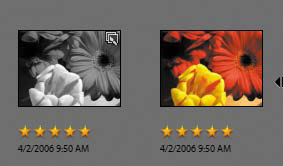Chapter 1. The Basics
In This Chapter
Before you start really working in Photoshop Elements, it’s good to take a look around the work area to familiarize yourself with the program’s tools and menus. The work area includes the document window, where you’ll view your images, along with many of the tools, menus, and panels you’ll use as you get better acquainted with the program.
Understanding the Work Area
The Photoshop Elements work area is designed like a well-organized workbench, making it easy to find and use menus, panels, and tools.
The Welcome screen
When you first start Photoshop Elements, the Welcome screen automatically appears ![]() . Click Organize to open the Adobe Elements 9 Organizer application, or click Edit to open the Adobe Photoshop Elements application. (You can bypass the Welcome screen by opening either of those apps by themselves.)
. Click Organize to open the Adobe Elements 9 Organizer application, or click Edit to open the Adobe Photoshop Elements application. (You can bypass the Welcome screen by opening either of those apps by themselves.)
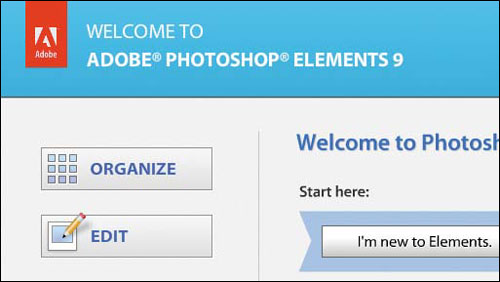
![]() The Photoshop Elements Welcome screen provides a simple and fast way to start organizing and editing your images.
The Photoshop Elements Welcome screen provides a simple and fast way to start organizing and editing your images.
The Organizer and the Editor
Photoshop Elements is made up of two separate components: the Organizer and the Editor, which can be (and often are) open simultaneously. The conventions in this chapter primarily apply to the Editor; the Organizer’s unique interface items are covered in Chapter 2.
Tip
Click the Settings button at the upper-right corner of the Welcome screen to set how Elements starts up ![]() .
.
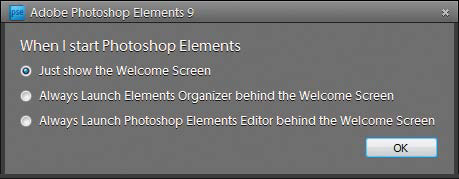
![]() Choose which parts of Photoshop Elements should launch at startup.
Choose which parts of Photoshop Elements should launch at startup.
Tip
Click the Home icon in the Organizer or the Editor to return to the Welcome screen at any time ![]() .
.

![]() The Home icon brings up the Welcome screen from anywhere within the program.
The Home icon brings up the Welcome screen from anywhere within the program.
Tip
If you have a Photoshop.com membership, go ahead and enter it at the Welcome screen—but it’s not necessary at this point. I cover Photoshop.com integration later in this chapter.
Menus, panels, and tools
The menu bar offers drop-down menus for performing common tasks, editing images, and organizing your work area. Each menu is organized by topic ![]() .
.
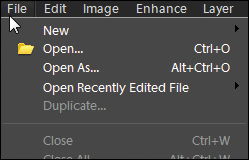
![]() The menu bar offers myriad drop-down menus, with commands you choose to help perform tasks.
The menu bar offers myriad drop-down menus, with commands you choose to help perform tasks.
The options bar, running above the work area, provides unique settings and options for each tool in the Tools panel. For instance, when you’re using the Marquee selection tool, you can choose to add to or subtract from the current selection ![]() .
.

![]() The options bar changes its display depending on the tool you select in the Tools panel.
The options bar changes its display depending on the tool you select in the Tools panel.
The Project Bin, located at the bottom of the desktop, serves as a convenient holding area for all of your open images ![]() . In addition to providing a visual reference for any open image files, the bin allows you to perform several basic editing functions. Click to select any photo thumbnail in the Project Bin, and right-click to display a popup menu. From the thumbnail menu you can get file information, minimize or close the file, duplicate it, and even rotate it in 90-degree increments.
. In addition to providing a visual reference for any open image files, the bin allows you to perform several basic editing functions. Click to select any photo thumbnail in the Project Bin, and right-click to display a popup menu. From the thumbnail menu you can get file information, minimize or close the file, duplicate it, and even rotate it in 90-degree increments.
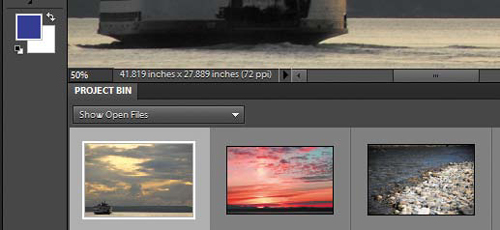
![]() The Project Bin is a holding area where you can access all of your open images.
The Project Bin is a holding area where you can access all of your open images.
The Panel Bin (also referred to as the Task Pane in the Organizer) groups common tasks and controls into the right edge of the window ![]() . Clicking a heading displays the panels for editing, creating, and sharing. To temporarily hide this area and make more room for working, choose Window > Panel Bin.
. Clicking a heading displays the panels for editing, creating, and sharing. To temporarily hide this area and make more room for working, choose Window > Panel Bin.
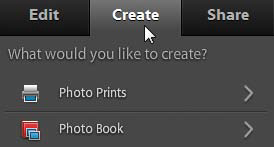
![]() Panels can be used from within the Panel Bin (as shown) or moved to your work area.
Panels can be used from within the Panel Bin (as shown) or moved to your work area.
When you’re in the Full Edit interface, the Panel Bin contains the Effects and Layers panels, and any other panel you open (such as the Adjustments panel when you apply an adjustment layer).
You can also drag a panel’s name to the main work area to display it as a floating panel. Panels can be grouped together or docked to one another, depending on your working and organizational styles (see “Working with Panels,” later in this chapter).
The Tools panel may be the single most important component of the Editor’s work area. It contains most of the tools you’ll use for selecting, moving, cropping, retouching, and enhancing your images. The tools are arranged in the general order you’ll be using them, with the most commonly used selection tools near the top, and the painting, drawing, and color correction tools toward the bottom.
The panel is docked on the left edge of the work area where the tools are displayed in a single, long column ![]() ; if your screen doesn’t accommodate all the buttons, the panel appears in a two-column format.
; if your screen doesn’t accommodate all the buttons, the panel appears in a two-column format.

![]() The Tools panel contains the tools to edit your images.
The Tools panel contains the tools to edit your images.
Tall or wide, the Tools panel can also become a floating panel: Drag the top of the panel away from the edge. Clicking the double-arrow button that appears switches between a one- or two-column layout.
Opening and Closing Files
Photoshop Elements provides several methods of opening photos, depending on whether you’re working in the Organizer or the Editor. (If you need to import photos into the Organizer, see Chapter 2.)
To open a file in the Organizer:
• Select a thumbnail and choose Edit > Edit with Photoshop Elements; the image opens in the Editor. You can also right-click an image and choose the same item from the contextual menu.
• With a thumbnail selected, click the pop-up menu to the right of the Fix tab in the Task Pane and choose one of the edit options, such as Full Photo Edit.
To open a file in the Editor:
- To find and open a file, choose Open from the File menu
 , or press Ctrl+O. The Open dialog appears.
, or press Ctrl+O. The Open dialog appears.
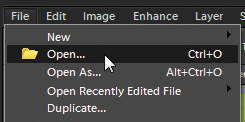
 Choose Open from the File menu to open an image file on disk.
Choose Open from the File menu to open an image file on disk. - Browse to the folder that contains your images
 .
.
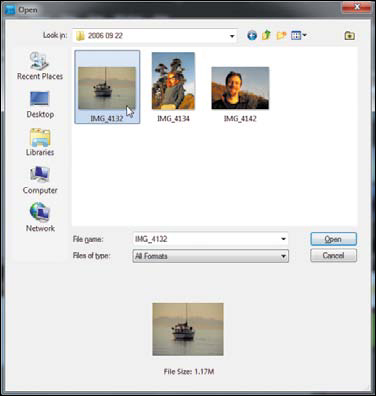
 The Open dialog displays all files that match formats Elements understands.
The Open dialog displays all files that match formats Elements understands. - To open the file you want, do one of the following:
• Double-click the file.
• Select the file and click the Open button.
The image opens in its own document window.
To close a file in the Editor:
• Click the close button on the title bar for the active window.
• From the File menu, choose Close, or press Ctrl+W.
Tip
If several files are open, you can close them all at once by choosing Close All from the File menu or by pressing Ctrl+Alt+W.
Saving Files
As you work on an image in the Editor, it’s good practice to save the file to your hard drive regularly. When you save a file, you can choose from a number of file formats. (For detailed information on the formats, see Chapter 13, “Saving and Printing Images.”)
If you’re interested in posting your photos to the Web, you can choose the Save for Web option. Saving your images for the Web involves its own set of unique operations; these are covered in detail in Chapter 12, “Preparing Images for the Web.”
To save a file:
From the File menu, choose Save, or press Ctrl+S.
To save a file in a new format or to a specific location:
- From the File menu, choose Save As, or press Ctrl+Shift+S. The Save As dialog appears
 .
.
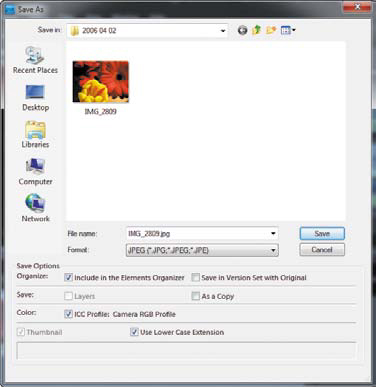
 The Save As dialog includes several options beyond just naming the new file.
The Save As dialog includes several options beyond just naming the new file. - Choose a destination for the file by browsing to a location.
- In the Save As field, type a name for the file.
- If you want to save the file in a different format, choose one from the Format drop-down menu.
If you’re not sure which format to use, choose either the native Photoshop format (PSD), which is the best all-purpose format, or the JPEG format, which works especially well with digital photos. When saving an image as a JPEG file, choose the highest quality setting possible (but be sure to review Chapter 13).
- If you want to be sure not to alter your original file, select the As a Copy option to save a duplicate. This selection protects your original file from changes as you edit the duplicate.
- To include color profile information, make sure the Embed Color Profile box is selected. For more information on managing color in your images, see Chapter 7, “Changing and Adjusting Colors.”
- When you’ve finished entering your settings, click Save.
Depending on the format you chose, you may be prompted to set other options, such as with JPEG files
 .
.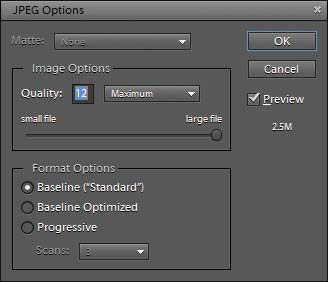
 Each image format has its own specific settings, such as those shown in this dialog for saving a JPEG file.
Each image format has its own specific settings, such as those shown in this dialog for saving a JPEG file.
Tip
Saving using the As a Copy option is a good idea if you’re experimenting with various changes and want to ensure that you keep your original version intact. It’s also handy if you want to save an image in more than one file format, which is useful if you want to save a high-quality copy for printing and keep a smaller-sized file to e-mail to friends.
Tip
Photoshop Elements allows you to customize how files are saved. From the Edit menu, choose Preferences > Saving Files. In the Saving Files dialog you can control how file extensions are displayed, choose whether to include image previews with your saved files (image previews are small thumbnail images that appear in the Open dialog when you select a file), and specify under what circumstances you would like to be prompted with the Save As dialog ![]() .
.
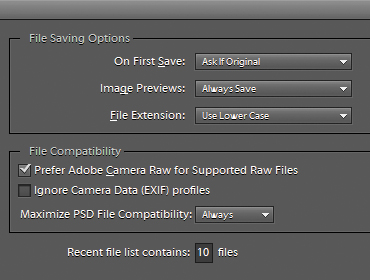
![]() Choose how files are saved in Photoshop Elements’ preferences.
Choose how files are saved in Photoshop Elements’ preferences.
Selecting Tools
The Tools panel contains all the tools you need for editing and creating your images. You can use them to make selections, paint, draw, and easily perform sophisticated photo retouching operations. To view information about a tool, rest the pointer over it until a tool tip appears showing the name and keyboard shortcut (if any) for that tool.
To use a tool, first select it from the Tools panel. Some tools hide additional tools, as indicated by a small triangle at the lower right of the tool icon ![]() .
.
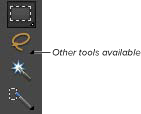
![]() A small triangle next to a tool icon indicates additional tools.
A small triangle next to a tool icon indicates additional tools.
To select a tool from the Tools panel:
Click the tool’s icon in the Tools panel.
When you move your pointer into the document window, the pointer changes appearance to reflect the tool you have selected ![]() .
.
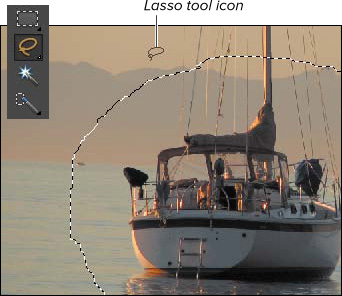
![]() When the Lasso tool is selected, the mouse pointer changes to the Lasso tool icon.
When the Lasso tool is selected, the mouse pointer changes to the Lasso tool icon.
To select a hidden tool:
- On any tool that displays a small triangle, either click and hold the mouse button, or right-click the tool icon. A menu of the hidden tools appears
 .
.
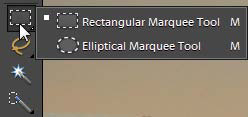
 Click and hold the mouse button or right-click to view the hidden tools.
Click and hold the mouse button or right-click to view the hidden tools. - Click to select the tool you want to use.
Tip
For easier access to tools, just use keyboard shortcuts. You’ll find them in tool tips, on the printed Quick Reference card included in the product box, and in the online help. For example, press T on your keyboard to activate the Type tool. (Note that when you press a letter to select a tool with a hidden tool group, Elements selects the tool from the group that was used most recently.)
Using the Options Bar
Think of the options bar as a natural extension of the Tools panel. After you select a tool, you can adjust its settings from the options bar. The buttons on the options bar change depending on the tool selected. If you’re using the Brush tool, for example, you can use the options bar to select a brush size and opacity setting.
To use the options bar:
- From the Tools panel, select a tool.
- In the options bar, choose an available option for that tool
 .
.
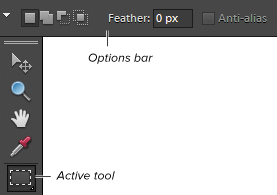
 Use the options bar to customize the tool you’ve selected, including selecting alternate tools.
Use the options bar to customize the tool you’ve selected, including selecting alternate tools.
Tip
In the Organizer, the options bar includes common tools such as Previous View and Next View, image rotation buttons, a slider for setting the thumbnail size, and others ![]() .
.
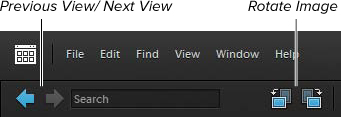
![]() The options bar in the Organizer contains commonly used tools.
The options bar in the Organizer contains commonly used tools.
Working with Panels
Although the Editor opens with just three panels displayed in its Panel Bin, a total of 10 panels are available from the Window menu. Each panel can be used entirely on its own or can be combined with other panels to help organize and streamline your workflow. All the panels feature handy drop-down menus that allow you to perform additional tasks or customize panel options.
To display a panel:
From the Window menu, choose any panel to display it in your work area ![]() .
.

![]() From the Window menu, show or hide any panel.
From the Window menu, show or hide any panel.
To move a panel out of the Panel Bin:
- Click the tab of the panel that you want to move from the Panel Bin.
- Drag the tab until the panel is in the desired location in your work area
 .
.
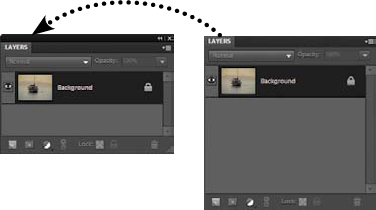
 To move a panel from the bin, drag the tab outside the bin; it becomes a stand-alone panel.
To move a panel from the bin, drag the tab outside the bin; it becomes a stand-alone panel.The panel is now a floating panel on the desktop.
To use panel menus:
Click the More menu in the upper-right corner of any panel ![]() .
.
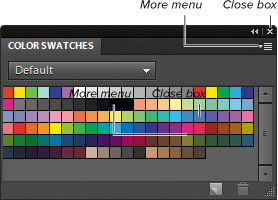
![]() The More menu includes more actions. To close a panel, click the close icon on the title bar.
The More menu includes more actions. To close a panel, click the close icon on the title bar.
To close a panel:
Do one of the following:
• From the Window menu, choose any open panel; open panels are indicated by a check mark.
• If the panel is open in your work area (outside the Panel Bin), click the close box on the panel title bar.
• If the panel is inside the Panel Bin, click the More menu and choose Close.
To return a panel to the Panel Bin:
Click the panel tab and drag the panel back into the Panel Bin. A horizontal blue line appears in the bin to indicate where the panel will end up when you drop it.
To group panels:
- Make sure you can see the tabs of all the panels you want to group.
- Drag a panel tab into the window of the target panel
 .
.
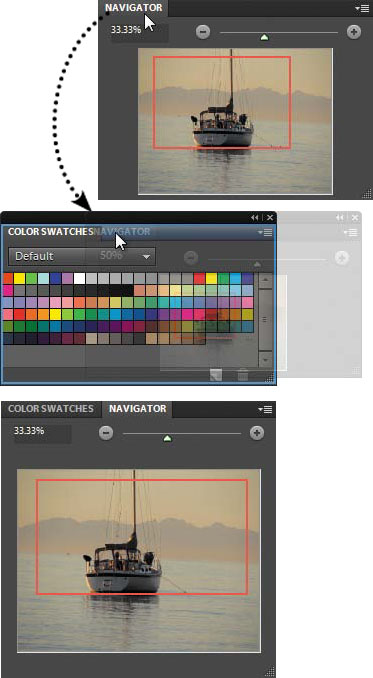
 Drag a panel tab into another open panel (top) to form a panel group (bottom).
Drag a panel tab into another open panel (top) to form a panel group (bottom).A thick line appears around the window of the target panel to let you know that the panels are about to be grouped.
To ungroup a panel, simply drag the panel’s tab out of the panel group.
To dock panels:
Drag any panel’s tab to the bottom of any panel outside the Panel Bin. Drag the panel by its title bar to successfully dock it to another panel ![]() .
.

![]() Docking one panel below another helps avoid clutter in your work area.
Docking one panel below another helps avoid clutter in your work area.
To undock a panel, click on one panel’s tab and drag it away from the other panel.
Tip
Pay attention to the blue line that appears when adding panels to the Panel Bin. A horizontal line indicates that the panel will be stacked with the rest. An outline means the panel will be added to a panel group.
Tip
If you choose to close a single panel residing in a panel group, the entire panel group will close. However, making one panel in the group visible using the Window menu makes the entire group visible again.
Double-click the panel tab or title bar ![]() . Double-click again to reveal the panel.
. Double-click again to reveal the panel.

![]() Double-click the panel tab to collapse a panel or panel group.
Double-click the panel tab to collapse a panel or panel group.
To collapse panels to icons:
Click the Collapse to Icons button at the top of a floating panel or panel group. This option gives you more additional workspace, at the expense of hiding controls. You can click the button again to expand the panels ![]() .
.
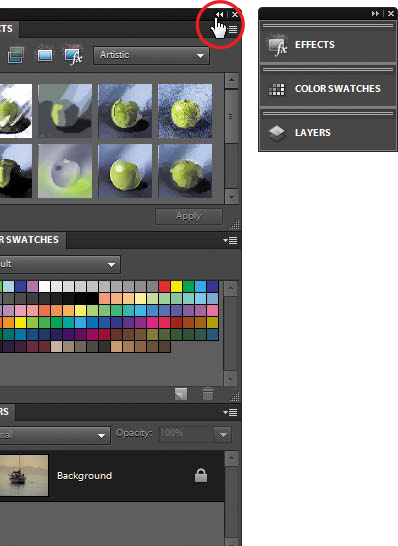
![]() Click the Collapse to Icons button to reclaim workspace from panels and the Panel Bin.
Click the Collapse to Icons button to reclaim workspace from panels and the Panel Bin.
Clicking a panel’s icon reveals the contents of only that panel.
To return panels to their default positions:
Click the Reset Panels button at the top of the Photoshop Elements window; or, from the Window menu, choose Reset Panels.
To hide the Panel Bin entirely:
From the Window menu, choose Panel Bin (so its checkbox goes away) to gain the most screen space for your image.
Using the Zoom Tool
It’s rare that you’ll want to view your images at one magnification level—editing out dust, for example, requires a close-up view. The Zoom tool magnifies and reduces your view, which you can control using a variety of methods.
The current level of magnification is shown in the document status bar and, when the Zoom tool is selected, in the options bar above the document window. In the options bar you can adjust the magnification either with the Zoom slider or by entering a value in the Zoom text field ![]() .
.
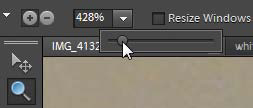
![]() With the Zoom tool selected, adjust the magnification level using a slider.
With the Zoom tool selected, adjust the magnification level using a slider.
To zoom in:
- In the Tools panel, select the Zoom tool, or press Z on the keyboard. The pointer changes to a magnifying glass when you move it into the document window.
- Be sure that a plus sign appears in the center of the magnifying glass. If you see a minus sign (–), click the Zoom In button on the options bar
 .
.
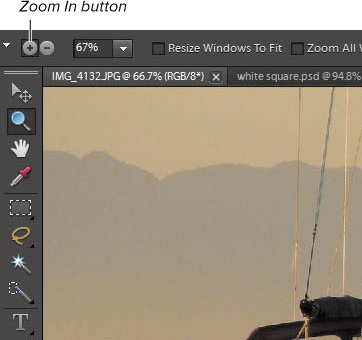
 To zoom in on an image, check that the Zoom In button is selected on the options bar.
To zoom in on an image, check that the Zoom In button is selected on the options bar. - Click the area of the image you want to magnify.
With a starting magnification of 100 percent, each click with the Zoom In tool increases the magnification in 100 percent increments up to 800 percent. From there, the magnification levels jump to 1200 percent, then 1600 percent, and finally to 3200 percent!
To zoom out:
- In the Tools panel, select the Zoom tool, or press Z on the keyboard.
- Click the Zoom Out button on the options bar, and then click in the area of the image that you want to zoom out from
 .
.
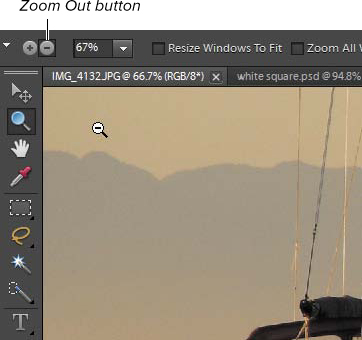
 To zoom out on an image, check that the Zoom Out button is selected on the options bar.
To zoom out on an image, check that the Zoom Out button is selected on the options bar.With a starting magnification of 100 percent, each click with the Zoom Out tool reduces the magnification as follows: 66.7 percent; 50 percent; 33.3 percent; 25 percent; 16.7 percent; and so on, down to 1 percent.
To zoom in on a specific area:
- In the Tools panel, select the Zoom tool; if necessary, click the Zoom In button on the options bar to display the Zoom tool with a plus sign.
- Drag over the area of the image that you want to zoom in on.
A selection marquee appears around the selected area
 . When you release the mouse button, the selected area is magnified and centered in the image window.
. When you release the mouse button, the selected area is magnified and centered in the image window.
 Drag with the Zoom tool to zoom in on a specific area of an image.
Drag with the Zoom tool to zoom in on a specific area of an image. - To move the view to a different area of the image, hold the spacebar until the hand pointer appears. Then drag to reveal the area you want to see. For more information on navigating through the document window, see “Moving Around in an Image” later in this chapter.
Tip
You can also change the magnification level from the zoom-percentage text field in the lower-left corner of the document window. Double-click the text field to select the zoom value, and then type in the new value.
To display an image at 100 percent:
To display an image at 100 percent (also referred to as displaying actual pixels), do one of the following:
• In the Tools panel, double-click the Zoom tool.
• In the Tools panel, select either the Zoom or Hand tool, and then click the 1:1 button on the options bar ![]() .
.

![]() Clicking the 1:1 button on the options bar returns the image view to 100 percent.
Clicking the 1:1 button on the options bar returns the image view to 100 percent.
• From the View menu, choose Actual Pixels, or press Ctrl+Alt+0.
• Enter 100 in the Zoom text field in the options bar, and then press Enter.
• Enter 100 in the status bar at the bottom of the document window, and then press Enter ![]() .
.
![]()
![]() Entering 100 in the status bar also changes the image view to 100 percent.
Entering 100 in the status bar also changes the image view to 100 percent.
Tip
With any other tool selected in the toolbar, you can toggle to the Zoom tool. Hold down Ctrl+spacebar to zoom in or Alt+spacebar to zoom out.
Tip
To change the magnification of the entire image, press Ctrl++ (Ctrl and the plus sign) to zoom in or Ctrl+– (Ctrl and the minus sign) to zoom out.
Tip
You can automatically resize the document window to fit the image (as much as possible) when zooming in or out. With the Zoom tool selected, click the Resize Windows to Fit checkbox on the options bar. To maintain a constant window size, deselect the Resize Windows to Fit option.
Moving Around in an Image
When working in Photoshop Elements, you’ll often want to move your image to make a different area visible in the document window. This can happen when you’re zoomed in on one part of an image or when an image is just too large to be completely visible within the document window.
To view a different area of an image:
Do one of the following:
• From the Tools panel, select the Hand tool and drag to move the image around in the document window ![]() .
.
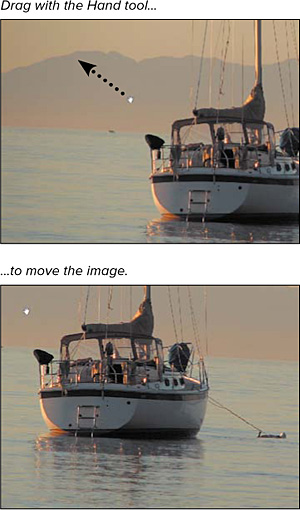
![]() To view a different area of the same image, drag with the Hand tool.
To view a different area of the same image, drag with the Hand tool.
• Use the scroll arrows at the bottom and right side of the document window to scroll to the left or right and up or down. You can also drag the scroll bars to adjust the view.
To change the view using the Navigator panel:
- Choose Window > Navigator to open the Navigator panel.
- Drag the view box in the image thumbnail
 .
.
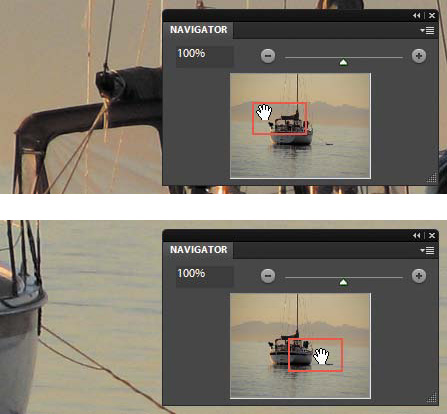
 You can also use the Navigator panel to view a different area of the same image.
You can also use the Navigator panel to view a different area of the same image.The view in the document window changes accordingly.
Tip
With any other tool selected in the toolbar, press the spacebar to give you temporary access to the Hand tool.
Tip
Drag the slider in the Navigator panel to adjust the magnification level in the document window.
Using Multitouch Gestures
If you own a device that accepts touch input—such as a laptop’s trackpad or a touch-sensitive screen—Photoshop Elements supports multitouch gestures that let you work in a more hands-on manner.
To rotate an image:
- Place two fingers on the multitouch surface.
- Turn your fingers clockwise or counterclockwise, like you’re turning a physical knob, to rotate the image 90 degrees in that direction
 .
.

 Rotate your hand to turn an image 90 degrees.
Rotate your hand to turn an image 90 degrees.
To zoom:
- Place two fingers on the surface.
- Pinch outward to enlarge the image (zoom in), or pinch inward to reduce the image (zoom out)
 .
.

 Pinch out to zoom.
Pinch out to zoom.
To scroll in an image:
- Place two fingers on the surface.
- Drag in the direction you wish to move the visible portion of the image
 .
.
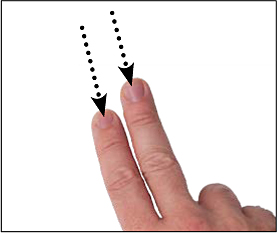
 Drag two fingers to scroll.
Drag two fingers to scroll.
Tip
Adobe calls the scrolling gesture a “flick,” because the image continues to move after you’ve lifted your fingers, depending on how you made the gesture. The movement approximates physics and quickly comes to a smooth stop.
Accessing Photoshop.com
Photoshop Elements integrates directly with Adobe’s Photoshop.com service, enabling you to publish photo albums directly (see Chapter 14). Recognizing the value of digital images, Adobe also added the capability to automatically back up your photos to Photoshop.com, so you have copies in case your computer or hard drive dies (see Chapter 2). And because your photos are online, you can view and edit them from any modern computer, not just the machine where Elements is installed.
A Basic Photoshop.com membership is free and includes 2 GB of online storage. Adobe also sells a Plus membership that costs $49.99 per year and includes 20 GB of storage, plus new ongoing tutorials, seasonal artwork, and templates delivered directly to Elements.
You can sign up for a Photoshop.com membership at the Welcome screen. After you’ve created an account, log in at the Welcome screen or by clicking the Sign In link at the top of the Organizer or Editor ![]() .
.

![]() Sign in to your Photoshop.com account, or click Create New Adobe ID.
Sign in to your Photoshop.com account, or click Create New Adobe ID.
Once you’ve signed in, Elements provides quick access to your settings and online photo gallery at the Welcome screen. You can also click the “Welcome, your name” link at the top of the Organizer or Editor.

